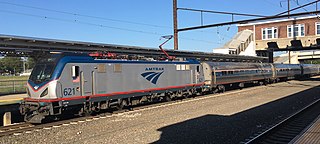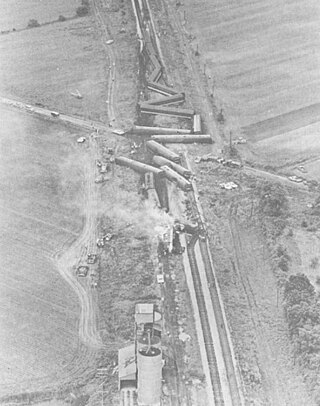
The Empire Service is an inter-city rail service operated by Amtrak within the state of New York in the United States. The brand name originated with the New York Central Railroad in 1967. Trains on the line provide frequent daily service along the 460-mile (740 km) Empire Corridor between New York City and Niagara Falls via Albany, the state capital.

The Keystone Service is a 195 mile regional passenger train service from Amtrak, that operates between the Harrisburg Transportation Center in Harrisburg, Pennsylvania, and 30th Street Station in Philadelphia, running along the Philadelphia to Harrisburg Main Line. Most trains then continue along the Northeast Corridor (NEC) to Penn Station in New York City.

The City of New Orleans is a long-distance passenger train operated by Amtrak in the Central United States between Chicago and New Orleans. The overnight train takes about 191⁄2 hours to complete its 934-mile (1,503 km) route, making major stops in Champaign–Urbana, Carbondale, Memphis, and Jackson as well as in other small towns.

The Lake Shore Limited is an overnight passenger train operated by Amtrak between Chicago and the Northeastern United States, with sections to New York City and Boston. The central segment of the route runs along the southern shore of Lake Erie. East of Chicago, the Lake Shore Limited follows the former main line of the Lake Shore and Michigan Southern Railway to South Bend, Toledo, Cleveland, and Buffalo. From here the train takes the Empire Corridor through Rochester and Syracuse to Albany–Rensselaer station in Rensselaer, New York. At that station, the train divides, with one section continuing to Springfield and Boston in Massachusetts, while the other continues along the Empire Corridor to New York City. The train is scheduled for 19+1⁄2–20+1⁄4 hours for the 959 miles (1,543 km) between Chicago and New York, and 21+1⁄2–22 hours for the 1,018 miles (1,638 km) between Chicago and Boston.

The Cardinal is a long-distance passenger train operated by Amtrak between New York Penn Station and Chicago Union Station via Philadelphia, Washington, D.C., Charlottesville, Charleston, Huntington, Cincinnati, and Indianapolis. Along with the Capitol Limited and Lake Shore Limited, it is one of three trains linking the Northeast and Chicago. The 1,146-mile (1,844 km) trip between New York and Chicago is scheduled for 281⁄4 hours.

The Illinois Zephyr and Carl Sandburg are a pair of passenger trains operated by Amtrak on a 258-mile (415 km) route between Chicago and Quincy, Illinois. As Illinois Service trains, they are partially funded by the Illinois Department of Transportation. Between Chicago and Galesburg, Illinois, the trains share their route with the California Zephyr and Southwest Chief; the remainder of the route (Galesburg–Quincy) is served exclusively by the Illinois Zephyr/Carl Sandburg.

The Lincoln Service is a 284-mile (457 km) higher-speed rail service operated by Amtrak that runs between Chicago, Illinois and St. Louis, Missouri. The train is a part of the Illinois Service and is partially funded by the Illinois Department of Transportation. The train uses the same route as the long-distance Texas Eagle, which continues to San Antonio and Los Angeles. A connection with the Kansas City-bound Missouri River Runner is available in St. Louis.

Michigan Services are three Amtrak passenger rail routes connecting Chicago, Illinois with the Michigan cities of Grand Rapids, Port Huron, and Pontiac, and stations en route. The group falls under the Amtrak Midwest brand and is a component of the Midwest Regional Rail Initiative.

The Illini and Saluki are a pair of passenger trains operated by Amtrak along a 310-mile (500 km) route between Chicago and Carbondale, Illinois. They are part of Amtrak's Illinois Service and are primarily funded by the state of Illinois. The service provides two daily roundtrips; Saluki being the morning trains and Illini the afternoon trains. The route is coextensive with the far northern leg of the long-distance City of New Orleans.

The Black Hawk was an Amtrak passenger train service that operated from 1974 to 1981 between Chicago, Illinois, and Dubuque, Iowa, via Rockford, Illinois. The original Black Hawk operated over the Illinois Central route, now the Canadian National's Chicago Central/Iowa Zone.

The Twin Zephyrs, also known as the Twin Cities Zephyrs, were a pair of streamlined passenger trains on the Chicago, Burlington and Quincy Railroad (CB&Q), running between Chicago and the Twin Cities of Minneapolis and Saint Paul in Minnesota. It was the second Zephyr service introduced by CB&Q after the record-setting Denver–Chicago "dawn to dusk dash" of the Pioneer Zephyr trainset.

Carbondale station is an Amtrak intercity train station in Carbondale, Illinois, United States. The southern terminus of Amtrak's Illini and Saluki routes, it is also served by the City of New Orleans. Amtrak Thruway service between Carbondale and St. Louis, Missouri connects with the City of New Orleans. Carbondale is the southernmost Amtrak station in Illinois.
The South Wind was a named passenger train equipped and operated jointly by the Pennsylvania Railroad, the Louisville and Nashville Railroad, the Atlantic Coast Line Railroad, and the Florida East Coast Railway. The South Wind began operations in December 1940, providing streamliner service between Chicago, Illinois and Miami, Florida. This was one of three new seven-car, all-coach streamliners operating in coordination every third day along different routes between Chicago and Miami. The other two longest enduring Chicago-Florida trains were the City of Miami and the Dixie Flagler. The South Wind remained in service through the creation of Amtrak in 1971.

The James Whitcomb Riley was a passenger train that operated between Chicago, Illinois, and Cincinnati, Ohio, via Indianapolis, Indiana. Originally operated by the New York Central Railroad, it was taken over by Amtrak in 1971. Under Amtrak, it merged with the Chesapeake & Ohio Railway's George Washington to become a Chicago-Washington/Newport News train. In 1977, it was renamed the Cardinal, which remains in operation.

The Shawnee was a passenger train operated first by then Illinois Central Railroad and then by Amtrak between Chicago, Illinois and Carbondale, Illinois. It operated from 1969 until 1986.

The Twilight Limited was a named passenger train in the United States which initially operated between Chicago, Illinois, and Detroit, Michigan. The New York Central Railroad introduced the train in 1926, and it continued until the formation of Amtrak in 1971, although it lost its name in 1967. Amtrak renamed the train St. Clair, feeling that the name "Twilight Limited" had undesirable connotations and imagery for a company trying to save passenger rail service. Amtrak revived the name in 1976 for a new train frequency on the Chicago–Detroit corridor, and kept the name until all trains on that corridor were renamed Wolverine in 2004.

The Maple Leaf was a passenger train pool operated by the Canadian National and the Grand Trunk Western Railroad between Chicago, Illinois and Toronto, Ontario. It operated from 1927 to 1971. The train took its name from the maple leaf, the national symbol of Canada. The Maple Leaf was one of many trains discontinued when Amtrak began operations in 1971, and is unrelated to the Maple Leaf which Amtrak now operates between Toronto and New York City. The train operated on Canadian National railroad territory through Ontario, but west of Lake Huron it operated via Grand Trunk Railroad.

The 1971 Salem, Illinois derailment occurred on June 10, 1971, when Amtrak’s City of New Orleans passenger train derailed near Salem, Illinois. It is sometimes referred to as the Tontiderailment, after the unincorporated community of Tonti, Illinois, which was the site of the crash. An investigation by the National Transportation Safety Board (NTSB) found that the derailment was caused by a false flange on a flat wheel caused by a seized axle bearing. The crash killed 11 people and injured 163. It was Amtrak's first fatal accident since assuming control of most intercity passenger trains in the United States on May 1, 1971.

The Borealis, referred to as Twin Cities–Milwaukee–Chicago (TCMC) during planning, is an Amtrak inter-city rail service that operates daily between Chicago, Illinois, and Saint Paul, Minnesota, via Milwaukee, Wisconsin. Service began on May 21, 2024, under the Amtrak Midwest brand.

















